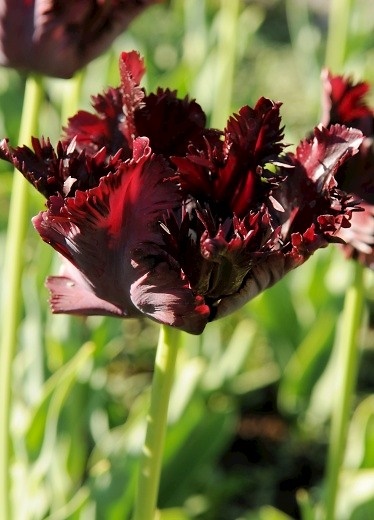Flowering period: mid-season to late
Average plant height: 35 – 50 cm
Spacing between bulbs: 7.5 cm
Type of bulb: bulb
Landscape uses: beds, borders and as cut flowers
These whimsically shaped and unusually colored tulips were developed from mutations of certain late-flowering tulips as well as from tulips in the Triumph group. Their petals are serrated or “fringed.” As their large blooms are exposed to the sun, they open so wide that they almost flatten out. The buds start off green, and as they grow you might think the tulips will remain entirely green. But as the flowers mature and open, their brilliant colors are revealed. At that point, the striking black, star-shaped center and bright yellow stamens become visible. Some varieties are called “bicolored,” but are in fact “tricolored” because of their ever-present green.
Although Parrot tulips generally have fairly sturdy stems, the sheer size of their flowers makes it wise to plant them in sheltered spots in the garden. The blooms are somewhat sensitive to prolonged cold and wet weather.
Most significant cultivars
- ‘Apricot Parrot’: bright apricot-coloured, pink striped
- ‘Black Parrot’: violet-black
- ‘Blue Parrot’: mauve-blue
- ‘Erna Lindgreen”: brilliant red
- ‘Estella Rijnveld’: red and creamy white
- ‘Fantasy’: bright pink
- ‘Flaming Parrot’: yellow and red
- ‘Orange Favourite’: bright orange
- ‘Rococo’: fire red
- ‘Salmon Parrot’: salmon, yellow striped
- ‘Texas Flame’: yellow and red
- ‘Texas Gold’: bright yellow
- ‘Topparrot’: cardinal red
- ‘Weber’s Parrot’: ivory-white, purple towards the edges
As is the case with most other tulip classes, these are also offered as mixed colours.

